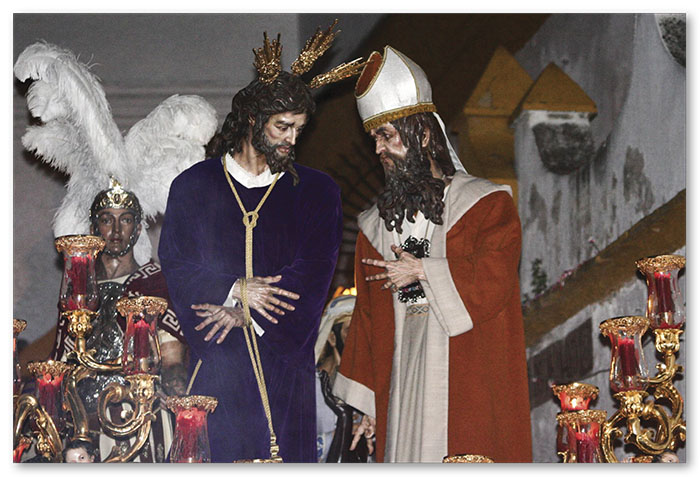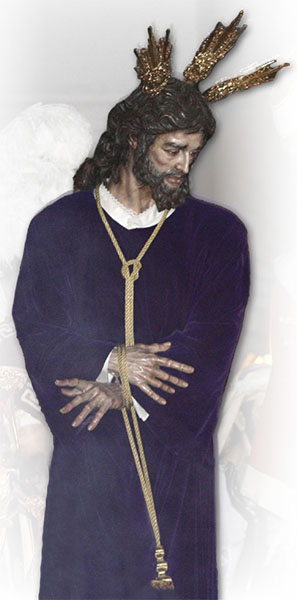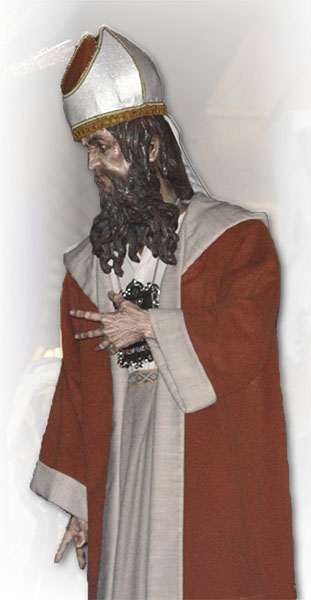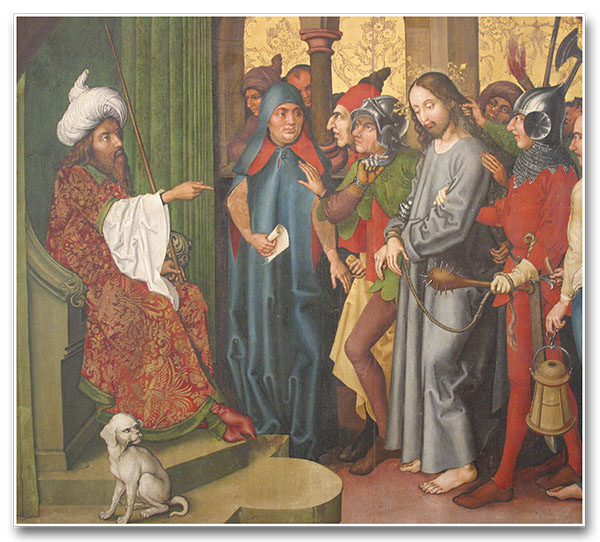In one of the most momentous scenes in history, the transient pontiff meets the Eternal Pontiff; the high priest of the Old Law meets the High Priest of the New Covenant; a christ meets the Christ; the prefigure meets its fulfillment.

Turning the pages of the Gospels, we are moved when we contemplate the marvels Our Saviour accomplished when He “became flesh and dwelt among us” (Jn 1:14). Impelled by infinite love, He brought us the Good News and confirmed it by countless miracles, not limited to restoring a natural well-being to the ailing, but aimed principally at reinstating in souls that union with their Creator that had been lost through sin.
In fact, the “time had fully come” (Gal 4:4), and humanity was to be the object of the greatest proof of divine love: the Redemption wrought by the Incarnate Word, to be accomplished at that most blessed moment of the “Consummatum est” (Jn 19:30).
Nevertheless, Our Lord willed that this sublime reconciliation be foreshadowed in various ways. One of these was the establishment of the Levitical priesthood in Aaron, through the mediation of Moses – an institution that was to usher in the manifestation of Jesus’ eternal priesthood to the world.
But the attitude of the religious authorities of Israel was quite different, and their rejection of the plans of Providence for them would be consummated in the trial of the Son of God at the outset of the Passion.
Levitical priesthood: prefigure of the eternal priesthood

The institution of the Levitical priesthood was intended to instate men who would serve as a bridge between humanity and God, in other words, who would be prefigures of the One who would effectively unite Heaven and earth.
This mission applied to the high priest above all, which is why he was designated with the term pontiff, whose etymology is bridge-builder. He held pre-eminence among the Levites (cf. Lv 21:10).
When he was consecrated, the pontiff was anointed with oil (cf. Lv 8:12; Nm 3:3). From a certain aspect he could thereby be considered a christ – meaning anointed, in Greek – which lent him yet another facet that prefigured the Messiah.
This was initially a life-long and hereditary office. Moreover, the position belonged to the descendants of Aaron, and not just to any Levite. However, the succession was interrupted at the time of the Maccabees, when Jonathan assumed the pontificate (cf. 1 Mc 10:20).
Herod the Great would later eliminate its life-tenure and, at the time of Our Lord, this title was practically purchased from the Roman rulers, then in power throughout Judea. Thus the high priesthood diverged enormously from the design that God had outlined for it in the Mosaic Law.
High priest at the apex of history
Three Gospels mention Caiaphas by name (cf. Mt 26:3,57; Lk 3:2; Jn 11:49; 18:13) as the high priest in office during the Saviour’s public life.
Was he a legitimate pontiff? St. John recognizes him as such (cf. Jn 11:51). Nevertheless, one thing is certain: from the moment he turned against Jesus Christ, denying that He was the Messiah, he became a usurper.
Married to the daughter of Annas, the former pontiff, he was appointed high priest by Valerius Gratus. The Lémann brothers,1 Jewish converts and priests of Christ, set his pontificate between 25-36 AD. He was deposed in the year 36 by Vitellius, governor of Syria, at the time of Pilate’s deposition.
A striking feature is his long tenure: his three predecessors did not manage to secure this high office for more than a year, and the five pontiffs who succeeded him most closely had tenures similar to theirs.
Being the high priest at that juncture of humanity’s history, would he not possess a singular vocation? We can legitimately ponder what this soul’s calling might have been. If Caiaphas had corresponded to grace, what wonders could have come about? He was meant to be a pontiff in all respects, for it was up to him to build the bridge connecting the old priesthood to the new. It was certainly his duty to humbly submit to Our Lord and, as it were, lay the millenary institution of the priesthood at His feet, soon to see it raised to the rank of a Sacrament.
What happened, however, was exactly the opposite: he unleashed a ferocious persecution against Him, whom he wrongly judged a threat to his stability in the pontificate, and finally effected Our Lord’s arrest, intent on condemning Him to death.
Two pontiffs meet

When the hour of the trial arrived, it was the encounter between two pontiffs. In fact, the transient supreme pontiff then met head-on with the Eternal Pontiff, the high priest of the Old Law with the High Priest of the New Covenant (cf. Heb 9:15), a christ with the Christ, the pre-figure with its full realization.
The so-called trial took place in the house of Caiaphas himself, where the Sanhedrin had gathered to manipulate the condemnation of the Just One at any price, even if this required numerous infractions from both a juridical and a religious standpoint.2
With one artifice after another, the members of this perfidious assembly spared no effort to achieve their objectives. The pontiff and Sanhedrin hierarchy seethed with fear, insecurity and haste, which led them to act recklessly.
They bribed men to provide false testimony. “That parade of ‘false witnesses,’ whose fraudulence was well-known, as St. Matthew clearly points out (cf. Mt 26:59-60), reveals an inconceivable level of perversity and moral deformity.”3
When this maneuver failed to yield the desired outcome, Caiaphas, launched a new attack, likewise illicit, to force the Savior to testify against Himself: “I adjure You by the living God, tell us if You are the Christ, the Son of God” (Mt 26:63).
To compel someone to testify in favor of his own condemnation is a completely illegitimate measure. Our Lord answers, not out of respect for an authority that lacks the right to interrogate, but because His silence on that occasion would be tantamount to a retraction.
As soon as Jesus categorically affirms that He is the Son of God, Caiaphas rends his garments, overcome with wrath as if he had just heard a blasphemy. St. Jerome offers an insightful commentary on this detail: “The prince of the priests rends his garments to show that the Jews had lost the glory of the priesthood and that the seat of the pontiffs was vacant.”4
What was the source of such hatred?
Beholding this scene, we might wonder where the source lay, of this great hatred that not only Caiaphas but also the other priests bore for Him who was the “hope of Israel” (Acts 28:20).
It could be argued that they were not aware that Our Lord was indeed the Messiah, come into the world. After all, did He Himself not ask for His executioners to be pardoned because they did not know what they were doing? Regarding this request of Jesus – the first words He uttered on the Cross – St. Thomas Aquinas5 distinguishes that the blame for the Divine Master’s condemnation fell differently upon two categories of people: the general public and the religious authorities.
The former asked for His death because they were spurred on by their leaders. However, Our Lord says that they were guilty, in spite of their ignorance, for no one asks pardon for someone who is free of fault. Indeed, among those who cried out “Crucify Him,” how many had not been healed, exorcised and forgiven by the Good Shepherd? Only God knows the number…
For their part, the Jewish authorities were sufficiently equipped, given their vast knowledge of the prophecies and Holy Scripture, to recognize Jesus as the Messiah. And the innumerable miracles He worked overwhelmingly verified this, as the high priests themselves confirmed when they declared that Our Lord had to die, otherwise all would believe in Him (cf. Jn 11:48). Moreover, in His final verbal exchanges with His opponents before the Passion, the Savior spared no theological and philosophical argument. And since the Sanhedrin members were unable to answer Him, we see that His reasoning was more than sufficient to finally convince them of His divine person and mission.
Blinded by hatred and envy, they preferred not to believe that He was the Son of God; and this culpable ignorance aggravated their guilt. For this reason, the Angelic Doctor concludes that the words of the Divine Crucified One applied to the humbler classes of the people, and not to the Jewish rulers.6
A worthless sentence?
The condemnation of Jesus ensued, and closure was reached in that trial “whose judges were devoid of moral weight, and whose sentence was devoid of juridic value,”7 in the words of the Lémann brothers.
The opinion of the two scholars is entirely reasonable, but is it absolute from every perspective? From the juridical standpoint, Our Lord’s condemnation was altogether worthless. But did this immense sin, perpetrated with consummate iniquity, not weigh in another field? Would such a condemnation not generate serious consequences?

A small detail in the Gospel of John may shed some light on the matter: the Apostle does not recount the trial that took place in Caiaphas’ house, but only mentions it (cf. Jn 18:24, 28). Why this silence, precisely on the part of the Evangelist who describes the Passion with the greatest wealth of detail?
Fr. Ignace de la Potterie8 comments that it is not easy to interpret a silence, since there may exist numerous reasons for not mentioning something. However, he hypothesizes that, unlike the other Evangelists, who try to stress the trial’s fraudulent aspect, the Beloved Disciple views it from a higher angle.
While the historical scenario presents us with the infamous condemnation of the Just One, the theological reflection points to an entirely different dimension: the entire Passion was a trial, in which Our Lord was the true Judge and the defendant was the world (cf. Jn 12:31). The vicissitudes of the iniquitous proceedings were of minor interest to St. John, for he could see, beyond those facts, the supernatural implications of what was going on: when Caiaphas and the other Judaic authorities clamored for the Crucifixion of the God-Man, they brought the sentence of condemnation down upon themselves.
Despite all evils, God always wins!
Regrettably, Caiaphas and the other chief priests were not faithful to the charge which God had entrusted to them of leading the people to Him – “the Way, the Truth and the Life” (Jn 14:6). On the contrary, they rejected Him with mortal hatred and condemned the Supreme Judge to death by means of an unjust judgment, imagining that they attained His utter defeat thereby.
However, even if the enemies of God multiply their conspiracies, He will not fail to carry out His plans. In truth, with the Passion, Death and Resurrection of Jesus Christ, the prophecies reached the apex of fulfillment. In being outraged, insulted, buffeted, condemned, scourged, crowned with thorns and finally put to death on the Cross, Our Lord won the greatest victory in history: He not only restored sinful humanity to union with God, perfectly fulfilling His role as Supreme Pontiff, but He also opened the gates of Heaven for us. ◊
Gospel
Then those who had seized Jesus led Him to Caiaphas the high priest, where the scribes and the elders had gathered. But Peter followed Him at a distance, as far as the courtyard of the high priest, and going inside he sat with the guards to see the end.
Now the chief priests and the whole council sought false testimony against Jesus that they might put Him to death, but they found none, though many false witnesses came forward. At last two came forward and said, “This fellow said, ‘I am able to destroy the Temple of God, and to build it in three days.’”
And the high priest stood up and said, “Have You no answer to make? What is it that these men testify against You?” But Jesus was silent. And the high priest said to Him, “I adjure You by the living God, tell us if You are the Christ, the Son of God.” Jesus said to him, “You have said so. But I tell you, hereafter you will see the Son of man seated at the right hand of Power, and coming on the clouds of Heaven.”
Then the high priest tore his robes, and said, “He has uttered blasphemy. Why do we still need witnesses? You have now heard His blasphemy. What is your judgment?” They answered, “He deserves death” (Mt 26:57-66).
Taken from the Heralds of the Gospel magazine, #174.
1 Cf. LÉMANN, Augustin; LÉMANN, Joseph. Valeur de l’assemblée qui prononça la peine de mort contre Jésus-Christ. 3.ed. Paris: Victor Lecoffre, 1881, p.32.
2 Regarding the transgressions that made the process that condemned Christ invalid, see the article: VIETO RODRÍGUEZ, Santiago. The Most Unjust and Infamous Judgement in History. In: Heralds of the Gospel. Nobleton. Vol. 12. No.125 (March, 2018); p.16-19.
3 CASTRILLO AGUADO, Tomás. Enemigos de Jesús en la Pasión, según los Evangelios. Madrid: FAX, 1960, p.104.
4 ST. JEROME. Comentario a Mateo. L.IV (22,41-28,20), c.26, n.261. In: Obras Completas. Madrid: BAC, 2002, v.II, p.391.
5 Cf. ST. THOMAS AQUINAS. Summa Theologiae. III, q.47, a.5-6.
6 Cf. Idem, a.6, ad 1.
7 LÉMANN; LÉMANN, op. cit., p.108.
8 Cf. LA POTTERIE, Ignace de. La Pasión de Jesús según San Juan. Texto y espíritu. Madrid: BAC, 2007, p.52-54.
